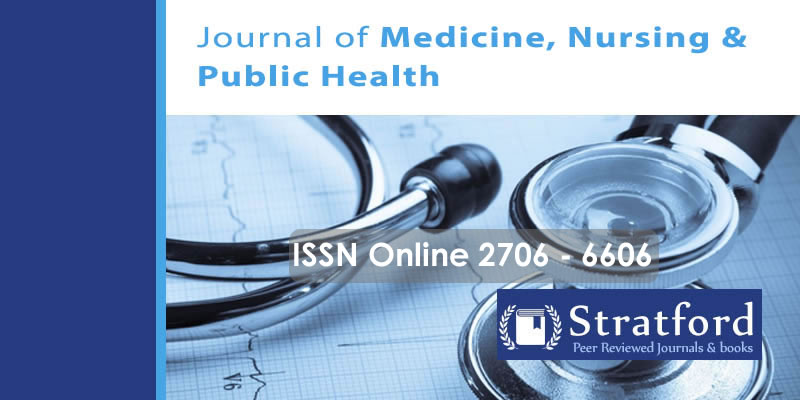Influence of Maternal Knowledge and Skills on Mixed Feeding Practices among Infants below 6 Months in Wajir County
DOI:
https://doi.org/10.53819/81018102t2260Abstract
Wajir County is estimation to have 749 deaths of infants below 6 months every year. In 2014, information from KDHS revealed that only 32% of infants below six months are wholly breastfed, their mothers introduce other foods, that is, weans their children instead of exclusive breastfeeding. The purpose of this study was to determine the how the mother/caregiver’s knowledge and skills influenced mixed feeding practices among infants below 6 months. The study adopted a descriptive cross- sectional study design in data collection through a quantitative approach, and the study target population comprised all the 802 mothers with infants below six months from which a sample size of 260 respondents was drawn. The data collected were analyzed using the Statistical Package for Social Sciences (SPSS) version 26. It was found that overall, the caregivers’ knowledge of all the mixed feeding indicators for a child with normal nutrition status was low. The knowledge was particularly low on continued breastfeeding, minimum meal frequency, minimum dietary diversity, and on how to feed a child during illness. Knowledge score at the time of introduction to mixed feeding and on giving vitamin A-rich fruits and vegetables was however high. It was recommended that the county Department of Health of Wajir, through the nutrition unit, needs to scale up Social Behavior Change Communication (SBCC) on mixed feeding targeting caregivers of children below 6 months of age with appropriate MIYCN information. The primary focus should be on continued breastfeeding, minimum meal frequency, and minimum dietary diversity.
Keywords: Maternal, infant and young child feeding practices, Exclusive breastfeeding, knowledge and skills, & mixed feeding
References
Afolabi, K. A., Afolabi, A. O., & Omishakin, M. Y. J. (2021). Complementary feeding and associated factors: Assessing compliance with recommended guidelines among postpartum mothers in Nigeria. Population Medicine, 3, 1-11. DOI: https://doi.org/10.18332/popmed/138939
Ahoya, B, Kavle, J.A, Straubinger, S, & Gathi. C. M. (2019) Accelerating progress for complementary feeding in Kenya: Key government actions and the way forward. Maternal Child Nutrition. ppl 1(Suppl 1), e12723. doi: 10.1111/mcn.12723.
Awuuh, V.A., Appiah, C.A. & Mensah, F.O. (2019), "Impact of a nutrition education intervention on nutritional status of undernourished children (6-24 months) in East Mamprusi district of Ghana", Nutrition & Food Science, 49(2), 262-272. https://doi.org/10.1108/NFS-05-2018-0134
Black, R. E., Bhandari, N., Mazumder, S., Bahl, R. Martines, J., & Bhan, M. K. (2013). An educational intervention to promote appropriate complementary feeding practices and physical growth in infants and young children in rural Haryana, India. The Journal of nutrition, 134(9), 2342-2348. DOI: https://doi.org/10.17511/ijphr.2020.i1.01
Jeelani, P., Ghai, A., Saikia, N., Kathed, M., Mitra, A., Krishnan, A., & Chidambaram, R. (2020). Baby foods based on cereals. In Food science, technology and nutrition for babies and children (pp. 59-97). Springer, Cham.
Kimani-Murage, E. W, Madise, N.J, Fotso, J. C, Kyobutungi, C, Mutua, M. K, Gitau, T. M, Yatich, N. (2011) Patterns and determinants of breastfeeding and complementary feeding practices in urban informal settlements. BMC Public Health. 11(396) 1-11. doi: 10.1186/1471-2458-11-396.
Kimiywe, J. &Chege, P.M. (2015) Complementary Feeding Practices and Nutritional Status of Children 6-23 Months in Kitui County, Kenya. Journal of Applied Biosciences, 85, 7881-7890. https://doi.org/10.4314/jab.v85i1.10
Lancet Child Survival Series (2021). Maternal and child under-nutrition progress. Available at: https://www.thelancet.com/series/maternal-child-undernutrition progress
Singh, T. (2010) Does International Trade Cause Economic Growth? A Survey. The world Economy 33(11). 1517-1564. https://doi.org/10.1111/j.1467-9701.2010.01243.x
Umugwaneza, M., Havemann-Nel, L., Vorster, H. H., & Wentzel-Viljoen, E. (2021). Factors influencing complementary feeding practices in rural and semi-urban Rwanda: a qualitative study. Journal of Nutritional Science, 10. DOI: https://doi.org/10.1017/jns.2021.37
United Nations Children's Fund (2013) Healthy Beginnings for a better Society Breastfeeding in the workplace is possible: a toolkit. https://www.ilo.org/wcmsp5/groups/public/---asia/---ro-bangkok/---ilo-manila/documents/publication/wcms_493121.pdf
Wade, C., Frazer, J. S., Qian, E., Davidson, L. M., Dash, S., te Water Naudé, A., & English, M. (2020). Development of locally relevant clinical guidelines for procedure-related neonatal analgesic practice in Kenya: a systematic review and meta-analysis. The Lancet Child & Adolescent Health, 4(10), 750-760.doi: 10.1016/S2352-4642(20)30182-6.
Zhou, Q, Younger, K.M, Cassidy, T.M, Wang, W, Kearney, J.M. (2020). Breastfeeding practices 2008-2009 among Chinese mothers living in Ireland: a mixed methods study. BMC Pregnancy Childbirth. 20(1), 51(1). doi: 10.1186/s12884-019-2713-9.


